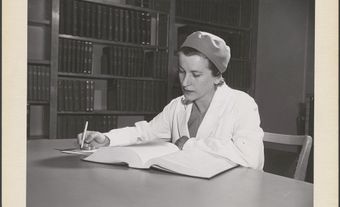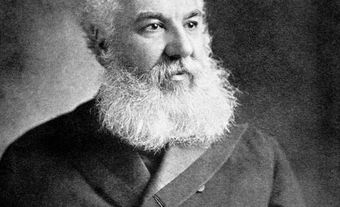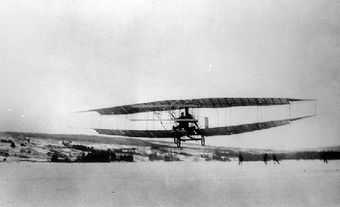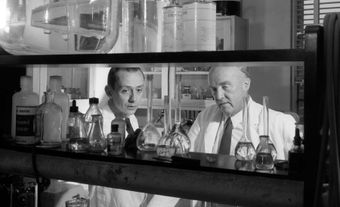Mabel Gardiner Hubbard Bell, aeronautics financier, community leader, social reformer and advocate for the deaf (born 25 November 1857 in Cambridge, Massachusetts; died 3 January 1923 in Chevy Chase, Maryland). Bell actively supported and contributed to the work of her husband, inventor Alexander Graham Bell. Her financial investment in his work made her the first financier of the aviation industry in North America. She was a community leader in Baddeck, Nova Scotia, where the Bell family spent their summers. She was also a social reformer and supported innovation in education.
Click here for definitions of key terms used in this article.

Mabel Hubbard Bell, financier, community leader and wife of Alexander Graham Bell.
Early Life and Education
Mabel Hubbard was born into a wealthy family in Cambridge, Massachusetts. Her mother, Gertrude Mercer McCurdy, was well educated. Her father, Gardiner Greene Hubbard, was a prominent lawyer. At the age of five, Mabel became sick with scarlet fever. As a result of her illness, she suffered hearing loss and her balance became impaired. At the time, sign language was the preferred method of educating deaf children. Most people assumed that, after losing their hearing, deaf children would lose their ability to speak.
Instead of sending her daughter to a school for deaf children, as was common at the time, Hubbard’s mother taught her at home. She later hired specialized tutors to work with her daughter. Her tutors used the oral method of education. This involved teaching Hubbard to lip-read, which helped her develop strong speaking skills. Because of this oral education, she was able to integrate into the community and attend school with hearing children.
Hubbard and her parents became advocates for deaf children. At the age of nine, she visited the Massachusetts legislature to speak in support of oral education methods, including lip-reading. She successfully answered questions about mathematics, history and geography. Hubbard’s clear speech demonstrated the effectiveness of the oral method. Between 1871 and 1873, she travelled through Europe with her mother and attended school in Vienna. (See also Deaf Culture.)
Marriage to Alexander Graham Bell

Mabel Hubbard Bell, Alexander Graham Bell and their children, Elsie May Bell (far left) and Marian Hubbard Bell.
After her return to the United States in 1873, Mabel Hubbard visited a speech teacher, Alexander Graham Bell, to see if he could help her improve her articulation. He specialized in working with deaf students using oral education. While Hubbard did not initially like her teacher, she grew to admire him and, later, to love him.
In 1875, the couple was engaged. On 11 July 1877, they were married in Cambridge, Massachusetts. Together, they had two sons and two daughters. Both boys died in infancy. The Bells lived in Washington, DC. Throughout their marriage, Mabel Bell actively supported her husband, who worked long hours as a researcher and an inventor. She offered financial and business advice throughout his career. She also managed the family’s finances.
Community Involvement
In 1885, the couple, along with their two daughters, made their first summer trip to Newfoundland. During this trip, they spent time in Baddeck, Cape Breton Island, Nova Scotia. They loved the area, so they purchased a farmhouse on the outskirts of Baddeck. The Bells returned every summer, sometimes for as long as six months at a time. They began to purchase land across the bay. The Bells named the land “Beinn Bhreagh,” which means “beautiful mountain” in Scottish Gaelic. Eventually, they built a large home on this land. Over time, the Bells also built wharves, workshops, roads and a laboratory.
During their summers in Baddeck, Mabel Hubbard Bell became deeply involved in the community. In 1891, she established the Young Ladies Club of Baddeck. Inspired by the women’s club in Washington, DC, the Young Ladies Club of Baddeck encouraged the education and support of women. (See Women’s Organizations.)
Bell was interested in education and innovative teaching methods. In 1895, she founded the Parents Association of Baddeck. This organization provided an opportunity for parents to participate in the education system. In 1912, Bell opened the first Montessori school in Canada, called the Children’s Laboratory. It was located on the family property on Beinn Bhreagh. She hired a Montessori teacher from New York to teach her grandchildren and other local children. Later that year, she also started a Montessori school in Washington, DC. Bell later became the first president of the Montessori Educational Association of America.
The townspeople of Baddeck deeply valued Bell’s contributions. The town passed a special ordinance that gave her the right to vote in municipal elections.
Financier of Aeronautical Research
Mabel Hubbard Bell’s interest in commercializing her husband’s research led her to become the first financier of the aviation industry in North America. During his career as an inventor, Alexander Graham Bell experimented with large kites. These tests eventually led to research into powered flight. He developed a strong yet light structure that was suited for flight by connecting tetrahedral kite cells. Recognizing the commercial potential of her husband’s invention, Bell helped him organize and fund a group devoted to aeronautical research.
In 1907, Bell financed the Aerial Experiment Association (AEA) with $35,000 of her own money. She helped her husband gather a team of aeronautical researchers. Many of their experiments took place in Baddeck. The AEA created four airplane prototypes and broke flight records. In 1908, they successfully flew their third prototype, June Bug, in a competition in Hammondsport, New York. There, they won the Scientific American Trophy for the first successful flight of at least one kilometre. Their fourth prototype, Silver Dart, made the first human flight in Canada.
The AEA disbanded in 1909 after the death of one team member and the departure of another. The remaining members formed the Canadian Aerodrome Company and continued their aviation research for another year.
On top of supporting her husband’s research, Bell performed her own scientific experiments in agriculture and food preservation, which included growing vegetables under various conditions. She sent her results to the Central Experimental Farm (Ottawa) and the Bureau of Soils (US).
Death and Legacy

Mabel Hubbard Bell died 3 January 1923 in Chevy Chase, Maryland, five months after her husband. She was buried next to his grave on Beinn Bhreagh.
Alexander Graham Bell’s aeronautical achievements are part of her legacy as his financier and supporter. Her work as a community leader and social reformer has also had a lasting impact. The Young Ladies Club of Baddeck (now the Alexander Graham Bell Club), which she established, may be the longest running women’s club in Canada. The Parents Association of Baddeck expanded across Canada and became the Canadian Home and School Federation, a national parent organization interested in public education.
In 2015, Bell received a posthumous honorary doctorate from Cape Breton University.

 Share on Facebook
Share on Facebook Share on X
Share on X Share by Email
Share by Email Share on Google Classroom
Share on Google Classroom









